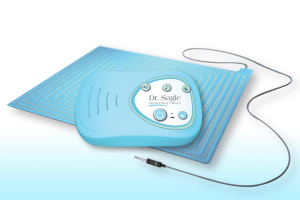The main types of bedwetting alarms

While there are many types of bedwetting alarms available on the market, most of them share the basic feature of an alarm that sounds in response to initial urine drops.
Broadly speaking, we can identify three types of alarms: buzzers (that are connected to the body with a wire); wireless buzzers; and “bell and pad.
Buzzer alarms
The bedwetting alarm is attached to the child’s pajamas and connected by a wire to a small moisture sensor, which is placed inside the child’s underwear.
🟩 Advantages:
- Relatively cheap.
- Small in size.
🟥 Disadvantages:
- Not always safe, as the metal sensor can become corroded because of the acidity of the urine and may cause bruising to the skin.
- Can cause skin irritation due to the child’s movement in bed.
- As the alarm is attached to the body, the child can unintentionally disconnect it.
- In some cases, the sound of the buzzer is not loud enough to activate the child’s reflex system. In some cases, the child’s blanket covers the alarm and dims its sound.
Wireless buzzer alarms
The difference from the typical wired buzzers is that wireless buzzers use a radio transmitter placed on the sensor plate on the lower. A radio receiver is installed in the alarm, which is attached to either the child’s pajamas or placed next to the child’s bed. When the child wets the bed, radio waves are transferred from the transmitter to the receiver, and the alarm is activated.
🟩 Advantages:
- Relatively cheap.
- Small in size.
- Wireless.
🟥 Disadvantages:
- Not completely safe – as placing a radio transmitter near and around the child can turn out to be very problematic.
Bell and pad alarms
Bell and pad bedwetting alarms are composed of two parts: the control unit (alarm) and a plastic detector pad, which is placed on the bed under the sheet.
🟩 Advantages:
- The pad is attached to the alarm by a slim wire, which does not disturb the child in bed.
- Doesn’t cause skin irritation, as no part touches the child’s body at all.
- Doesn’t use dangerous radio waves.
- Safe to use.
🟥 Disadvantages:
- Not as cheap as the other types of alarms, as it costs more to manufacture.
>> Visit our FAQ section for more information about bedwetting treatment
>> To learn more about our plans and pricing click here
Search
Recent Posts
- Summer Sleepovers and Bedwetting: A Parent’s Guide to Confidence and Comfort
- Hot Weather and Bedwetting in Children: What You Should Know
- Springtime and Bedwetting in Children: What’s the Connection?
- Understanding Restraint Mechanisms and Bedwetting in Children
- Giggling and Bedwetting: Why Laughter Sometimes Leads to Leaks
Categories
- ADHD
- adult bedwetting
- All about Bedwetting
- bed wetting
- bed wetting alarms
- bed wetting treatment
- bedwetting
- bedwetting blog
- bedwetting causes
- Bedwetting Dictionary
- bedwetting medication
- bedwetting solution
- bedwetting solutions
- bedwetting therapee
- bedwetting therapy
- diurnal enuresis
- dribbling
- How to stop bed wetting
- nappies
- News
- primary enuresis
- progress chart
- secondary enuresis
- sleep
- sleepovers
- The Solution – Therapee
Tags
Archives
- June 2025
- May 2025
- March 2025
- November 2024
- October 2024
- September 2024
- August 2024
- May 2024
- April 2024
- March 2024
- February 2024
- January 2024
- December 2023
- September 2023
- August 2023
- July 2023
- June 2023
- May 2023
- April 2023
- March 2023
- February 2023
- January 2023
- December 2022
- November 2022
- October 2022
- September 2022
- August 2022
- July 2022
- June 2022
- May 2022
- April 2022
- March 2022
- February 2022
- January 2022
- December 2021
- November 2021
- October 2021
- September 2021
- August 2021
- July 2021
- February 2015
- January 2015
- December 2014
- November 2014
- October 2014
- September 2014
- August 2014
- July 2014
- June 2014
- May 2014
- April 2014
- March 2014







